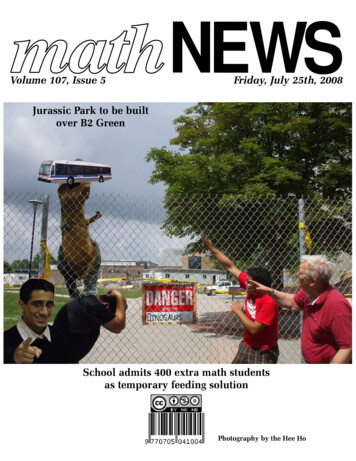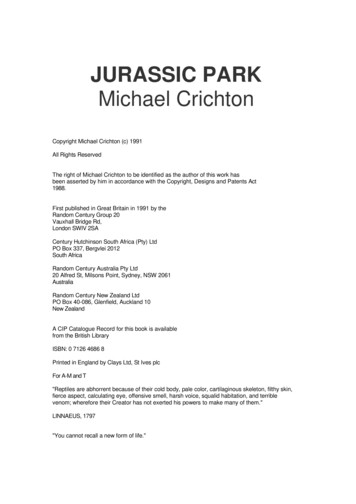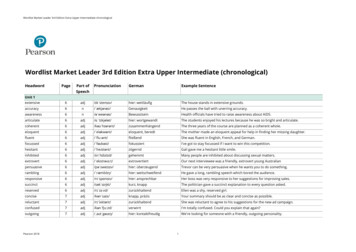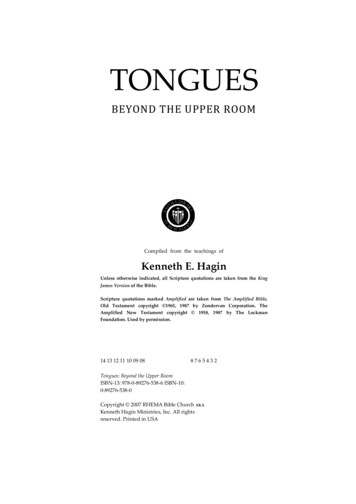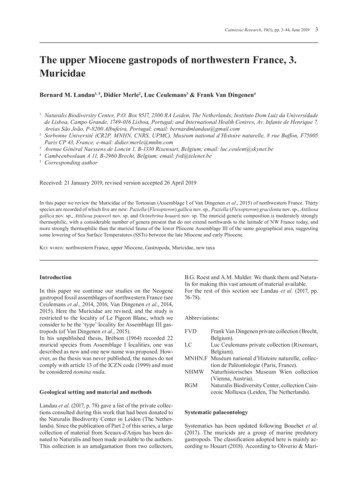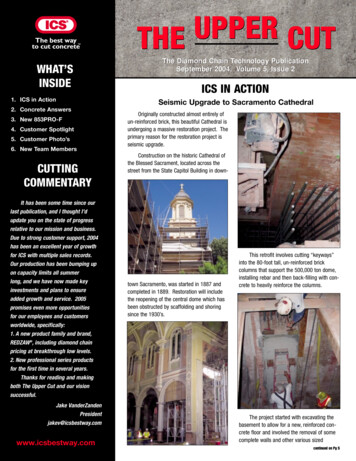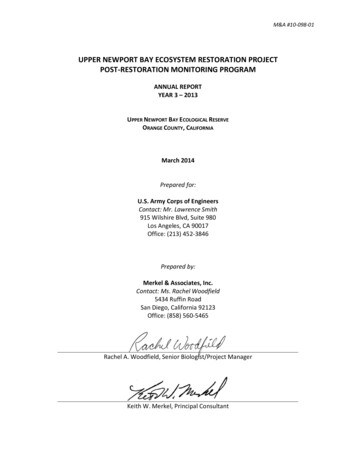
Transcription
J(Upper Jurassic Stratigraphyof Some Adjacent Parts ofTexas, Louisiana, andArkansasGEOLOGICAL SURVEY PROFESS I ON AL PAPER 594-E
Upper Jurassic Stratigraphyof Some Adjacent Parts ofTexas, Louisiana, andArkansasBy KENDELL A. OLOGYSURVEY PROFESSION1A.L PAPER 594-Eol.A discussion of the nomenclature, lithologicharacter, thicknesses, and the relation oflithofacies to paleotectonic elements of Upp rJurassic rock strataUNITED STATES GOVERNMENT PRINTING OFFICE, WASHINGTON: 1968
UNITED STATES DEPARTMENT OF THE INTERIORSTEWART L. UDALL, SecretaryGEOLOGICAL SURVEYWilliam T. Pecora, DirectorFor sale by the Superintendent of Documents, U.S. Government Printing OfficeWashington, D.C. 20402 - Price 65 cents (paper cover)
CONTENTSAbstractIntroductionPurpose and scopeStructural settingAcknowledgments omenclatureStratigraphy ethodsNorphlet FormationSmackover FormationThickness and distributionStratigraphic relationsLower member iddle memberUpper memberPaleotectonic relationsPagePageE1123366999101011111212Buckner Formation ----------Thickness and distribution - -Stratigraphic relations -Lower member -- -Upper memberPaleotectonic relations --Cotton Valley Group --- -- - -------------Bossier FormationThickness and distribution -Stratigraphic relations -QtonguePaleotectonic relationsSchuler Formation ----Thickness and distributionStratigraphic relationsPtonguePaleotectonic relationsReferences TIONSPagePLATE1. Correlation of electric and interpretive sample logs of Upper Jurassic rocks in some adjacent parts of Texas,FIGURE1.2.3.4.5.6.7.8.9.Louisiana, and Arkansas In pocketshowing area of report in relation to the updip limit of Upper Jurassic rocks and to present major structuralfeatures of gulf coast -------------------------E2Isopach map of Upper Jurassic rocks and locations of major ancestral structural features3Diagrammatic cross section showing structural and stratigraphic relations from margin to deeper part of hart showing history of nomenclature of Upper Jurassic rocks in gulf coast embayment7Isopach map of Smackover Formation10Lithofacies map of upper member of Smackover Formation12Isopach map of lower member of Buckner Formation ·13Isopach map of upper member of Buckner Formation14 ap showing relations of anticlines to southern edges and depositional axes of lower and upper members opach map of Bossier Formation -------18Lithofacies map of Schuler Formation ------20 ap10.11.12. Isopach map of Schuler Formation except P --------13. Isopach map of P tongue of Schuler ----------------2324TABLEPageTABLE1. ames and locations of some wells in Texas, Arkansas, and Louisian&-------------------------------------mE5
SHORTER CONTRIBUTIONS TO GENERAL GEOLOGYUPPER JURASSIC STRATIGRAPHY OF SOME ADJACENT PARTS OF TEXAS, LOUISIANA,AND ARKANSASByKENDELLABSTRACTThe Smackover and Buckner Formations and the CottonValley Group, which is composed in ascending order of theBossier and Schuler Formations, are of definite' Late Jurassicage. The Norphlet Formation, although considered to be of LateJurassic age, is unfossiliferous and its age is unproven. TheHaynesville Formation, which is composed of part of the CottonValley Group and the Buckner Formation, is' not used here.The Upper Jurassic rocks are found only in the suibsurface atdepths generally ranging from 1,000 feet along the north edgeof the gulf coast embayment to 12,000 feet in Louisiana. Theirthicknesses and lithologic characteristics were affected by contemporaneous regional movement along the Sabine uplift andthe north Louisiana basin and by local movement of anticlinesand faults along the margin of the gulf coast embayment. TheSmackover and Buckner Forma:tions and the Cotton ValleyGroup are characterized by varied lithology and by lack oflateral cm11tinuity. No regional unconformities are apparent inthe Upper Jurassic rocks.The Smackover Formation is divided into three informalmembers-lower, middle, and upper. The lower member consists predominantly of d-ark-brown silty to argill-aceous limestone that is commonly laminated. It is recognized over a muchwider region, particularly in downdip areas, than the middleand upper members. The middle member, which is predominantly dense limestone, and the upper member, which is predominantly oolitic limestone, are confined to the north marginsof the gulf coast embayment in the report area. Southward fromdowndip areas the middle and upper members grade laterallyinto the Bossier Formation.The Buckner Formation, which in the report area is confinedto the north margin of the gulf coast embayment, is dividedinformally into lower and upper members. The lower member,which consists mostly of anhydrite and anhydritic mudstone,was deposited in a narrow basin that paralleled the margin ofthe embayment. It is apparently limited along its south side bya series of salt-cored anticlines that were forming at the timeof deposition and were partly responsible for restricting theoutflow of hypersaline water from the marginal basin. Theupper member, which consists mostly of mudstone and shale, isfound throughout the area of the lower member and evenfarther south where it is thickest. It is apparently limited onthe south by a second series of anticlines. An earlier conceptfua:t reef growth within the Smackover Formation was theprincipal cause of evaporite deposition in the Buckner Formntion now seems to be incorrect.A.DICKINSONThe Bossier Formation is here redefined to include all darkgray shale above the lower member of the Smackover Formation and below the basal sandstone of the Schuler Formation.It thus includes' equivalelllts of the middle and upper membersof the Smackover Formation, all the Buckner Formation, andpart of the Schuler Formation. A thin upper part of the Bossierextends northward into the lower part of the Schuler Forma.tionand is here informally termed the Q tongue of the BossierFormation.The Schuler Formation is here redefined to inC'lude all rocksbetween the top of the Buckner Formation and the base of theCretaceous rocks, except for the Q tongue of the Bossier F'ormation. A sandstone and shale tongue that underlies the Q tongueof the Bossier is here informally termed the P tongue of theSchuler. In updip areas the Schuler Formation is largely nearshore or nonmarine in origin, and in downdip areas to the! southit is marine. The near-shor'e or nonmarine facies: consists oflenticular light-gray, pink, or reddish-brown fine-grained sandstone and pastel varicolored and reddish-brown shale. Thenormal marine facies consists of light-gray fine-grained sandstone, clark-gray fissile fossiliferous shale, and some limestone.T·,vo conspicuous unconnected conglomera tic facies are foundin the lower part of the Schuler Formation; one is updip inthe nonmarine facies and the other is downdip in the marinefacies.INTRODUCTIONThe Upper Jurassic rocks are entirely subsurf eunits that underlie much of the gulf coast embaymentin eastern Texas, southern Arkansas, Louisiana, centraland southern Mississippi, and southwestern Alabama(fig. 1). The Smackover and Buckner Fonnations andthe overlying Cotton Valley Group which is comprisedof the Bossier and Schuler Formations are definitelyof Late Jurassic age. The Norphlet Formation is alsogenerally believed to be of Late Jurassic age, but itslack of fossils makes determination more difficult. Itoverlies the Louann Salt of Jurassic ( ?) age. The CottonValley Group is overlain by the Hosston Formation ofEarly Cretaceous age.The Upper Jurassic rocks lie at depths of 1,000-3,000feet at their north edge in southern Arkansas and northeastern Texas, at about 12,000 feet in northern LouisiE1
E2SHORTER CONTRIBUTIONS TO GENERAL GEOLOGYgs 36·r--------------- ---------------------- ---------------- '\IOKLAHOMArTENNESSEEARKANSASI - - - - t .SOI 100.JI MILESGULFoF28· -- L -- FIGURE1.-Area of report (crosshatched) in relation to approximate updip limit of Upper Jurassic rocks and to presentmajor structural features of gulf coast embayment.ana and eastern Texas, and at even greater depths incentral Louisiana and southeastern Texas where theyhave not been penetrated by drilling. In southernMississippi rocks of Late Jurassic age have been foundbelow 20,000 feet. The Upper Jurassic rocks maintainrelatively uniform thicknesses in downdip areas, butthey thin to a featheredge along the northwest, north,and northeast margins of the gulf coast embay1nent.The thickness of the Upper Jurassic rocks in the reportarea is shown in figure 2, and the structural and stratigraphic relations between the northern (updip) andthe southern ( downdip) parts of the report area areshown in figure 3. The nearest outcrops of Upper J urassic rocks are in the Malone Mountains of south western Texas, and in Mexico and Cuba.PURPOSE AND SCOPEThis report presents a revised nomenclature and somenew stratigraphic interpretations made on the basis ofnew data, the reevaluation of old data, and the applica-tion of new structural concepts. Further investigationsinto the petrography and origin of each unit are underway, and reports on these subjects are planned. Therevision of stratigraphic· nomenclature in this reportincludes a rank change of one unit and the redefinitionof several formations. The impracticability of using thesame formational nan1es for widely different sedimentary facies is demonstrated. No new formal terms areproposed and an attempt is made to follow originaldefinitions.The nmnenclature used here is based primarily ona study of rocks in the western part of the ancestralnorth Louisiana basin and of rocks on the ancestralSabine uplift and, therefore, may not be entirely suitable for use in the east Texas basin or in other partsof the gulf coast embayment. Each basin within thegulf coast embayment has a somewhat distinctive depositional and lithologic character. Formational unitnames, such as Smackover and Schuler, may be generally applied throughout the embayment, but to a large
UPPER JURASSIC STRATIGRAPHY, ADJACENT PARTS OF TEXAS, LOUISIANA, ARKANSASE3ishes, La. The total area is approximately 9,800 squaremiles.STRUCTURAL SETTINGEXPLANATIONControl wells Entire Upper Jurassicpenetrated--3500--IsopachDashed where approximate.Interval 500 feet/Upper Jurassicpartly penetratedFIGURE2.-Isopach map of Upper Jurassic rocks and locationsof major ancestral structural features.The tectonic elements that existed in the gulf coastembayment during Late Jurassic time have remainedunchanged to the present, except that their axes haveshifted. During the Late Jurassic Epoch the Sabineuplift occupied the west half of the present report areaand the north Louisiana basin occupied the east half.The axis of each tectonic feature shifted eastward,however, so that the pre.sent Sabine uplift occupiesmost of the report area 'and the north Louisiana basinlies directly to the east of the uplift (fig. 1) . Both theancestral and present Sabine uplifts are separated fromthe north margin of .the gulf coast embayment by anortheast-trending extension of the east Texas basin.Smaller basins have been formed along the marginsof the gulf coast embayment because of the concurrentgrowth of synclines and anticlines. According to Bornhauser (1958), gravitational flowage of the underlyingLouann Snlt formed many of these folds, but somefolds, according to Fowler (1964), resulted from othertectonic activity.Parts of the Mexia-Talco and south Arkansas faultsystems and other normal faults are present in thereport area (fig. 1). The Mexia-Talco fault systemborders the north margin of the enst Texas basin andapparently extends into the report area from the westin southern Bowie County, Tex. The .south Arkansasfault system extends from ,the southwest corner ofArkansas, east and northeast across Miller and Lafayette Counties in the report area, and then eastwardacross south-central Arkansas. These fault systems andthe Pickens-Gilbertown fault system of Mississippi andAlabama are generally parallel to and south of thenorthern limit of Upper Jurassic rocks in the gulf coastembayment.Many of these faults bound grabens that formed nearthe crests of anticlines. Movement along these faults wasassociated with the formation of salt domes or saltcored anticlines during the Late Jurassic. Another largefault, the Rodessa, .strikes northeastward across MarionCounty, Tex., and adjacent parts of Louisiana andArkansas (fig. 1).METHODSextent they must be redefined in each local basin or othernames must be applied (Murray, 1961, p. 290).The area of this report lies in the northwestern andnorth-central parts of the gulf coast embayment (fig.1) and includes Bowie, Cass, !arion, Harrison, Panola,and Shelby Counties, Tex.; Lafayette and MillerCounties, Ark.; and Bossier, Caddo, and DeSoto Par-Rotary drill cuttings and (or) cores were examinedfrom 40 wells. Electric logs from 39 of these wells andfrom an additional 150 wells were studied. For wellnames and locations see Dickinson ( 1968}. Supplementary data were obtained from commercial sample logs,especially if samples were not available to the author.Where interpretive sample logs based on commercial
SouthwesternArkansas(updip area)FEET BELOWSEA LEVEL26 1819Northwestern Louisiana ·(downd
Correlation of electric and interpretive sample logs of Upper Jurassic rocks in some adjacent parts of Texas, . and includes Bowie, Cass, !arion, Harrison, Panola, and Shelby Counties, Tex.; Lafayette and Miller Counties, Ark.; and Bossier, Caddo, and DeSoto Par-ishes, La. The total area is approximately 9,800 square miles. STRUCTURAL SETTING The tectonic elements that existed in the gulf .
